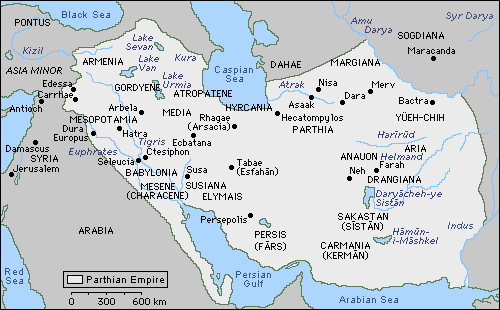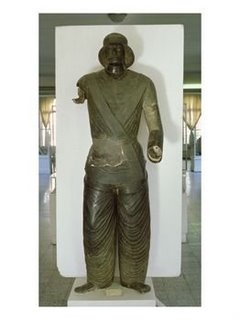The posts in this weblog are mainly about history, heritage, language, art, and culture of Persia (that is named Iran since 1934). Persia is, therefore, equal to Iran, and Persian is equal to Iranian. Note that Persian is a nationality not an ethnicity. Pars (or Fars) is the major ethnicity in Persia but there are also Persian Kurds or Arabs. Similarly, the official language in Persia is Persian (Farsi is the local name and may not be used internationally). For more details please read my posts.
Thursday, August 03, 2006
The second Persian Empire (1): Parthian
The second Persian Empire existed for about 900 years! It consists of two different dynasties; Parthian and Sassanid. I consider both dynasties together the second Persian Empire for the following reasons:

Let me say a few things about Parthian Persian Empire in this post. In the next post, I will tell you more about Sassanid Persian Empire.
The Parthians defeated Alexander the Great's successors, the Seleucids, conquered most of the Middle East and southwest Asia from about 250 B.C. until about 225 A.D. (almost five centuries!). Their capital city was Ctesiphon (Persian: تیسفون pronounce: tisfun), which also remained as the capital city of their successor, the Sassanid Persian Empire. Ctesiphon is located approximately 20 miles southeast of the modern city of Baghdad, Iraq, along the river Tigris. I will tell you more about this city when I write about the Sassanid Persian Empire.
Ctesiphon, unfortunately, is not registered in the Unesco World Heritage list yet. There are news that many destructions have happened to the remaining of this city in the last few years, with no national or international effort to prevent that. If you who read this page are in a position to talk it louder and let the world know, please do so. It is such a pity to loose a precious heritage like that so easily.
Another important city of Parthian Persian Empire is Hatra, which was later the capital of the Arab Kingdom. This city is also located in Iraq, and, fortunately, is registered in Unesco World Heritage. See a beautiful photo of Hatra here. Today Hatra, which remains mostly unexcavated, is in a very worrying state of conservation. Parts of the site have been fenced off to protect it from possible looting

One of the most fasinating items that remained from Parthia period is the life-sized bronze statue of a Parthian prince. It has only one arm, but the rest of it is intact. This statue is so famous that it is almost impossible to talk about Parthians without mentioning that statue. It is now kept in the National Museum of Iran (Persia).
If you like to read about the second Persian Empire, the Parthians, here are some internet resources. You can, of course, find more if you search Google.
Parthian.com
Wikipedia
LIVIUS Articles on Ancient History
Iran Chamber Society
(although Iran is frequently used in this site, please remember that Persia is the better name of the country as I discussed in my previous post: Persia today).
- Both dynasties were Persian (from Persia), although Parthians had different ethnicity than Pars.
- The Parthian Persian Empire continued with the Sassanid Persian Empire. There was no invasion or destruction of the Persian Empire in between. That is different for Achaemenids Persian Empire (the first one), which ended up with the invasion of Alexander the Great, and Sassanid Persian Empire, which ended up with the invasion of Arabs.

Let me say a few things about Parthian Persian Empire in this post. In the next post, I will tell you more about Sassanid Persian Empire.
The Parthians defeated Alexander the Great's successors, the Seleucids, conquered most of the Middle East and southwest Asia from about 250 B.C. until about 225 A.D. (almost five centuries!). Their capital city was Ctesiphon (Persian: تیسفون pronounce: tisfun), which also remained as the capital city of their successor, the Sassanid Persian Empire. Ctesiphon is located approximately 20 miles southeast of the modern city of Baghdad, Iraq, along the river Tigris. I will tell you more about this city when I write about the Sassanid Persian Empire.
Ctesiphon, unfortunately, is not registered in the Unesco World Heritage list yet. There are news that many destructions have happened to the remaining of this city in the last few years, with no national or international effort to prevent that. If you who read this page are in a position to talk it louder and let the world know, please do so. It is such a pity to loose a precious heritage like that so easily.
Another important city of Parthian Persian Empire is Hatra, which was later the capital of the Arab Kingdom. This city is also located in Iraq, and, fortunately, is registered in Unesco World Heritage. See a beautiful photo of Hatra here. Today Hatra, which remains mostly unexcavated, is in a very worrying state of conservation. Parts of the site have been fenced off to protect it from possible looting

One of the most fasinating items that remained from Parthia period is the life-sized bronze statue of a Parthian prince. It has only one arm, but the rest of it is intact. This statue is so famous that it is almost impossible to talk about Parthians without mentioning that statue. It is now kept in the National Museum of Iran (Persia).
If you like to read about the second Persian Empire, the Parthians, here are some internet resources. You can, of course, find more if you search Google.
Parthian.com
Wikipedia
LIVIUS Articles on Ancient History
Iran Chamber Society
(although Iran is frequently used in this site, please remember that Persia is the better name of the country as I discussed in my previous post: Persia today).
Labels: Persian history

